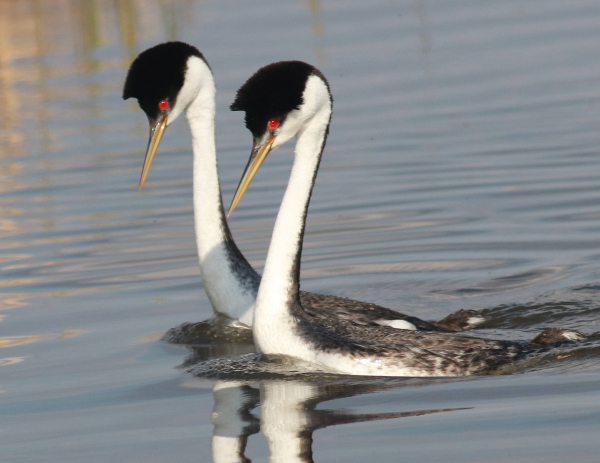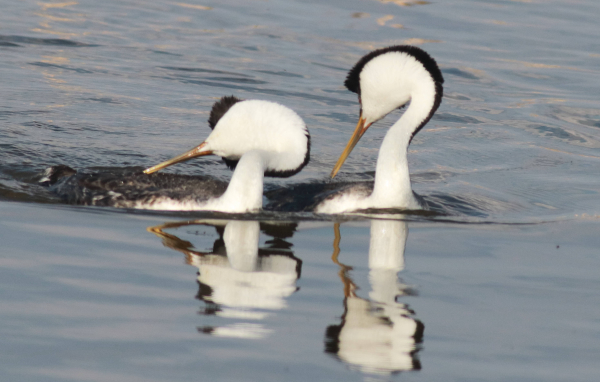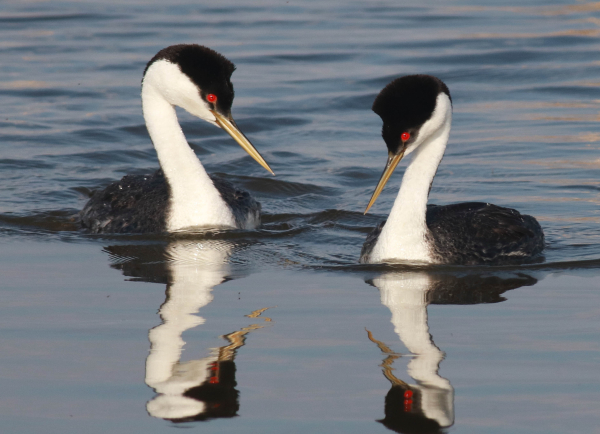After last week’s pheasant fight, of course I had to return to McKenzie Slough when I drove to Bismarck last Wednesday. My timing was right again for fine lighting, and the afternoon clouds cleared for prime time – all I needed were some cooperative birds, or better yet, some impressive birds. No luck during my drive south along the road that bisects the expansive marsh, but upon my return, a pair of Western Grebes was positioned in calm open water – and after I settled into position, I was thrilled when they began displaying together – what luck! I spent about 20 minutes with the pair as they interacted during a series of mating displays.

The female calling during her “advertising” display. This pleasing photo shows the excellent lighting, image sharpness, and calm water that give you the feeling of being in the right place at the right time.
|
It was a great chance to document the action, and I was a little surprised the pair approached my position and displayed openly so close to me, but I’ve had that kind of luck lately, so rather than question it, I appreciated it – and McKenzie Slough came through again!
The sequence of displays performed by the pair has been well documented by ornithologists, who have named the varied postures such descriptive titles as the advertising display, ratchet display, high arch display, and bob-preening display, among others. While displaying, the grebes often added vocal aspects to the display, calls that I personally enjoy and would describe as raspy but pleasing high-pitched calls.
As the grebes performed their sequence of displays, I imagined that at any moment the pair might rise up and do a short “rushing” display, the characteristic ‘dance’ of the pair ‘running’ side by side synchronously on top of the water. But that intense display tends to be performed later in the season, and in much more open water areas than this relatively small marsh opening surrounded by cattails.
Photo Editing

The pair greeted each other with the “ratchet” display, holding their head low and pointing their bill at the other bird, while holding their feather crest erect, extending their bulging cheeks, and holding their small tail erect.
|
After documenting all the grebe behaviors in the field, as always it was exciting to review the series of digital photos I took on the big screen of my computer. Editing photos is almost as enjoyable and important as taking the photos. Editing tends to be a two part process: 1) reviewing the photos and selecting the images you want to share with others; 2) cropping the photos if needed, and saving each selected photo with an appropriate file name. When naming file photos that are part of a series, such as the grebe photos, it’s best to give them a numerical or alphabetical designation that will display them in your preferred order: 1 to 5, or A to E, for example.
The timing of my photography is not by accident; if it’s a sunny day, I usually wait until late afternoon to begin any birding activities beyond my home or office. That way, if a photo opportunity presents itself, the light is best, as long as I am positioned between my subjects and the sun – photographing with the sun at my back.
In this case, I had passed several Western Grebes and a host of other birds that were on the “wrong side” of the road that bisected the big marsh. After passing all the wrong-side birds on my drive south, when I returned on my northward pass, I was lucky to find the pair of grebes that provided my best Western Grebe display photos to date – in perfect light.
Approach and Techniques

The mutual “high arch” display is impressive to witness at close quarters. Western Grebes are among the best examples of birds with highly developed innate behavioral mating displays.
|
To approach birds, you need something of a buy in from the birds; that is, I always hope the birds will accept my approach and my presence. I approach slowly at an angle, rather than directly at the birds. I tend to turn my vehicle’s engine off a few moments before I reach my location, then coast more silently into my intended position. I also don’t approach too close. I know birds pretty well, and I know the power of my telephoto lens, so I try to keep my distance when possible, so the birds are comfortable and act naturally rather than react to my presence.
As my vehicle coasts the last few feet forward, I already have my camera in hand and in position before the vehicle stops to minimize any movements. I keep quiet and motionless as much as possible, and when my efforts work out best I become all but invisible to the birds. Some birds won’t permit any level of photo approach, so when you find birds that are trusting, that’s always a plus that we can use to our advantage. I brace my lens against the window frame, hold my breath when pressing the shutter button, and rely on the autofocus to keep the birds in focus, especially when they are in motion.
With two birds active in close quarters, I was alert about the proximity of one bird to the other as they swam and displayed. I wanted to keep my shutter speed as fast as possible, and was able to keep my aperture at a standard f8, which usually provided an adequate area of focus that included both grebes. When one bird left the plane of focus, I simply waited for it to move closer to its intended mate.
As usual, I set the Mode Dial on my camera to the Av setting, then turned my aperture preference to f8. In response, the camera automatically selects the corresponding shutter speed under the ambient lighting conditions. (I never use an automatic setting on my camera, and encourage all photographers to choose a better option, such as the Av setting for aperture preference.)
Researching the Birds

The mutual “bob-preening” display includes the pair pointing at their back simultaneously. The pair performed these displays together in a sequence that is intended to unite them as mates in advance of the nesting season.
|
As a birding activity, photography should lead you to learn more about the birds you are able to photograph. I have observed and photographed Western Grebes for decades, but this time I reached for another level of appreciation by researching the names of the grebe displays I was documenting, along with their context during the pre-nesting period.
Perhaps that’s just me, the inquisitive biologist, but I think seeing or photographing new birds should be an impetus to learning more about them – how they behave, their nesting strategies, their wintering and nesting ranges, and anything else that comes to mind. The best location for that activity is the Birds of the World website.
Monday Addendum!
There were two advanced displays that the McKenzie grebes didn’t perform – the afore-mentioned “rushing” display and the “weed dancing” display. These are advanced displays that tend to be performed a little later in the mating process. But while checking on some local Western Grebes about a mile north of home Monday morning, I positioned my mobile blind adjacent to a pair that was doing a low-level “bob-preening” display. The female dived, and suddenly surfaced with aquatic plants hanging from her beak. She faced the male, stretching her neck upward a bit.
The male dived, and the female dropped her plants (as if disappointed) and dived too. In a moment both grebes surfaced with plants in their bill, faced one another and performed the “weed dancing” display, with me photographing the entire sequence, undoubtedly with a look of excited surprise. The birds stretched their necks and upper body high and circled one another with their crests erect and their throats expanded. It was very exciting to behold, but in a few moments the pair dived again, and that was that; they didn’t display again. Even so, it was a great opportunity to document the weed dancing display, and I’m hoping to follow up with photos of a “rushing” display soon.
After comparing the weed dancing images with the McKenzie grebe photos that illustrate this article, the photo I selected really didn’t fit into the McKenzie images – it looked out of place because it was taken at a different time of the day, with harsher light that is fine when the photo is viewed separately. I did want to share a weed dancing photo with you though, and offer it for your review in this issue’s Editor Afield article (picky-picky-picky).
Ambassadors

The “low arch” display provided an attractive portrait of the active Western Grebe pair. Selecting the photos to edit and use to illustrate a message to share with others – via online media, email, or text – is a fulfilling part of the creative process of bird photography.
|
Here in the northern prairie-wetlands complex, grebes are an important part of the waterbird avifauna, in addition to the variety of ducks and geese, coots and rails, pelicans and cormorants, and more. It seems that each species eventually provides photo opportunities that illustrate various aspects of their natural history through “ambassador” birds – individual birds that provide a wonderful opportunity to document their behavior, beauty, and biology. When that happens it provides an exciting opportunity for photographers, so we need to be prepared with our camera ready and field techniques in mind. The chance of interacting with ambassador birds should fuel searches for more May photo ops to enjoy!
Article and photos by Paul Konrad
Share your bird photographs and birding experiences at editorstbw2@gmail.com